Last updated: March 29, 2024
Article
"Webster Replying to Hayne"
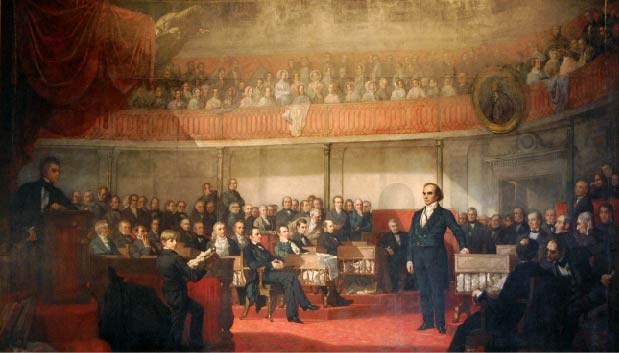
Museum of Fine Arts, Boston
On January 26, 1830, hundreds gathered in the Old Senate Chamber in Washington DC. They waited for Daniel Webster, Senator from Massachusetts, to take the floor for a much-anticipated rebuttal to Senator Robert Hayne of South Carolina. In what became known simply as his "Second Reply to Hayne," Webster delivered a stirring address. He systematically refuted the policy of nullification espoused by Southern senators, a policy that supported a state's right to nullify—or ignore—federal law. Instead, Webster called for national unity, which helped resolve a constitutional crisis. As he stated in his closing remarks, "Liberty and Union, now and forever, one and inseparable."[1]
In a debate that began over federal land policy and tariffs on imported goods, Webster successfully maneuvered to a larger discussion about the need for a strong federal government. Widely discussed across the nation, his striking speech caused many to feel that Webster won the debate. His "second reply" not only helped establish a newfound nationalism but also solidified Webster's place as one of the United States's best orators of the 19th century. The speech is captured in George P. Healey's 1851 painting "Webster Replying to Hayne," which today hangs in the Great Hall of Faneuil Hall.
Websters' address proved to be a major success in 1830, however deeper social and economic issues lay behind the larger debate. Despite his calls for Union and obedience to the Constitution, Webster fought for strong federal power to protect Northern elite's industrial interests. His opponents from the South supported nullification and other policies to protect the institution of slavery. These competing regional interests only intensified over the next few decades and ultimately led to Webster's political downfall. The underlying tensions exploded into civil war a generation later.
The Tariff
Webster's second reply to Hayne did not occur in a vacuum. It was the culmination of an early battle over economic, social, and political differences among the Northeastern, Western, and Southern sections of the United States. As historian Harlow Shiedley wrote,
Webster was primed to perform before a national audience riveted by the fierce sectional struggle raging in the senate…Thomas Hart Benson of Missouri moved to build an alliance between the West and the South by portraying the two sections as victims of federal tariff and land policies designed to serve their interests. The ensuing "Great Debate" lasted five months…[2]
This federal tariff referenced by Shiedley, known as the Tariff of 1828, divided the nation. It bolstered protections for Northern industries because imports, namely British, would undercut locally produced factory goods. However, the tariff had as much to do with politics as economics. With the looming 1828 election, supporters of both Andrew Jackson and the current president John Quincy Adams jockeyed for popular support and used the tariff to score political points. Supporters of each candidate proposed amendments to the bill, not to make it a stronger piece of legislation, but in an effort to make their opposition look bad. As historian H.W. Brands wrote,
Through the murk and mire, it became nearly impossible to discern definite principles in the positions of the opposing sides.[3]
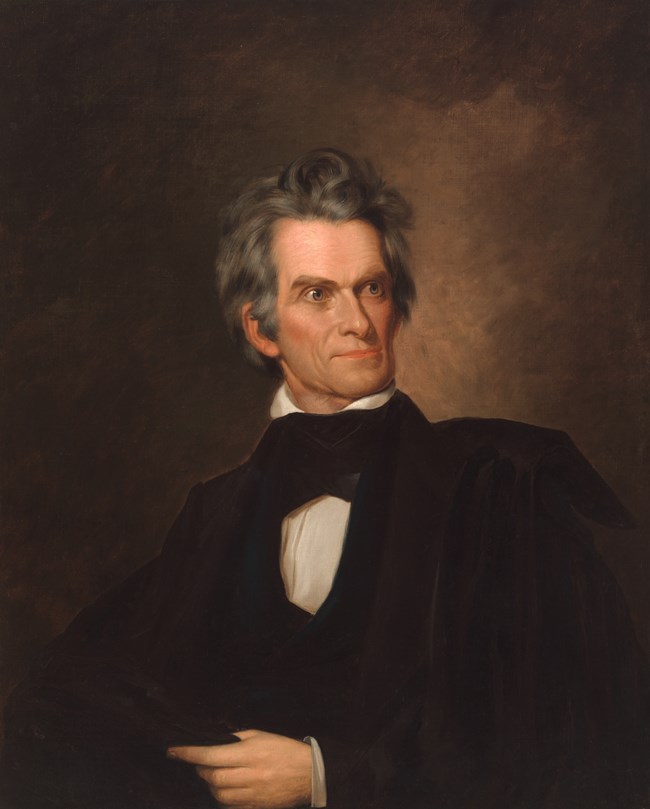
National Portrait Gallery, Smithsonian Institution
The final tariff passed in 1828 and proved to be a major win for Northern manufacturers. Imports from outside of the United States faced a rate increase upwards of 50%. This increased cost meant higher overall prices for goods, which hurt consumers.[4] With little mutual benefit for the South, as the majority of factories were located in the North, Southerners began to refer to the tariff as the "Tariff of Abominations."
John C. Calhoun, Vice President of the United States in 1828, served as one of the loudest voices in opposition to the tariff. Calhoun represented the elite slaveholding planter class in Congress and believed this new series of duties to be a gross overreach of the federal government. In response, Calhoun authored a 35,000-word attack on the tariff's legality. In what became known as the "Calhoun's Exposition," Calhoun wrote that the tariff was "Unconstitutional, unequal and oppressive; calculated to corrupt the public morals, and to destroy the liberty of the country."[5] To combat this encroachment of federal law, he proposed that a state should be able to call a convention and declare a law or an act "null and void." Calhoun's theory of nullification threatened the very fabric of the federal government. It sparked a crisis that led to Daniel Webster's Second Reply to Hayne.
The Speech
In January of 1830, Samuel Foot, a senator from Connecticut, proposed a resolution on the Senate floor that called for a review of how the government surveys and sells Western land. In response to the amendment, Robert Hayne, senator from South Carolina, attacked not only the amendment, but the Tariff of 1828 and the entire Northeast.[6] Webster felt compelled to defend the region he represented. In his first reply, Webster skillfully shifted the debate from the issue of the resolution to larger topics of nationalism, slavery, nullification, and the role of the federal government. Hayne responded in kind, attacking Webster for bringing slavery into the debate and his previous support of free trade. Hayne ended the speech with a strong defense of nullification. Instead of immediately responding in the waning hours of the day, Webster yielded the floor so he could better prepare his response. Excitement spread throughout Washington in anticipation of Webster's reply. [7]
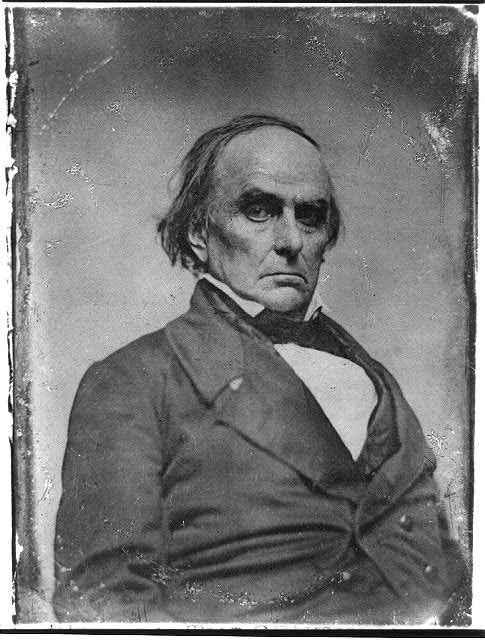
Library of Congress
The next day, people filled the Senate chamber gallery, eager to hear Webster's response. He did not disappoint. Over the next few hours, Webster thoroughly refuted Hayne and delivered a resounding defense of the Union and the Constitution. He spoke against nullification as a viable solution to determine the constitutionality of law and argued that nullification, if put into practice, would lead to civil war. Webster finished his speech by proclaiming,
Nor those other words of delusion and folly, 'Liberty first, and Union afterwards' but everywhere, spread all over in characters of living light, blazing on all its ample folds, as they float over the sea and over the land, and in every wind under the whole Heavens, that the other sentiment, dear to every American heart- Liberty and Union, now and forever, one and inseparable![8]
At the conclusion of the speech, the crowd greeted Webster with a stunned silence. As historian Robert Remini wrote about the reaction, "They did not applaud; they did not shout their appreciation. They just sat as if 'in a trance, all motion paralyzed.'"[9] Webster won the debate. But the underlying issues of sectionalism and slavery proved to be Webster's political downfall.
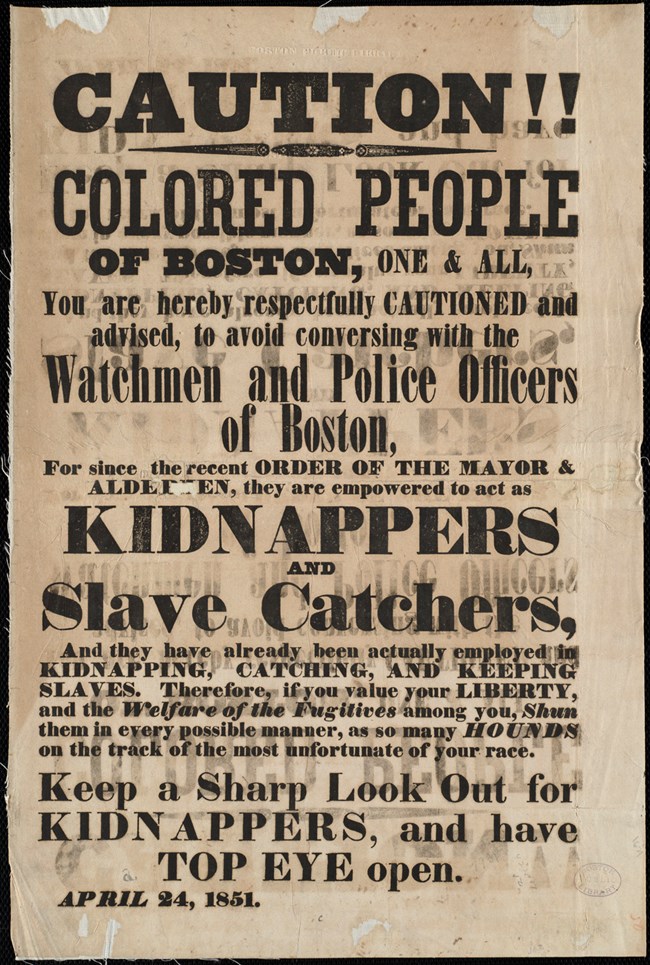
Boston Public Library
The Aftermath
In the two decades that followed "Webster's Second Reply to Hayne," the United States continued on a path of expansion through the forced displacement and removal of Indigenous nations. With this expansion the sectional divide over slavery only deepened and, in 1850, it nearly tore the country apart. The California territory, seized from Mexico during the Mexican American War in 1848, applied for statehood in 1850 after a large influx of settlers due to the discovery of gold. The California Constitution banned slavery and the territory wanted to enter the Union as a free state This led to a crisis: the addition of California would lead to an imbalance of free states versus slave states represented in Congress. Southerners began to threaten secession.
Trying to keep the country together, Henry Clay, longtime politician from Kentucky nicknamed 'The Great Compromiser,' came out of retirement to attempt one final compromise. In what became known as the Compromise of 1850, Clay proposed a series of resolutions to appease both slave and free states.[10] Among the most important, Clay called for California to be admitted as a free state. To offset California, he put forward a new Fugitive Slave Act that strengthened the fugitive clause of the Constitution. The proposal of the Fugitive Slave Law immediately met outrage and protest from the Northern states. For this compromise to succeed, Clay needed the support of Daniel Webster.
Throughout his career, Webster never identified with the abolition movement, though he believed slavery immoral. As he states in his second reply to Hayne, "I regard domestic slavery as one of the greatest evils, both moral and political…"[11] However, Webster felt that slavery should not be interfered with where it already exists. From the same speech he stated,
Whatever pain I may experience from them will not induce me…to overstep the limits of constitutional duty or to encroach on the rights of others. The domestic slavery of the Southern States I leave where I find it, in the hands of their governments. It is their affair, not mine.[12]
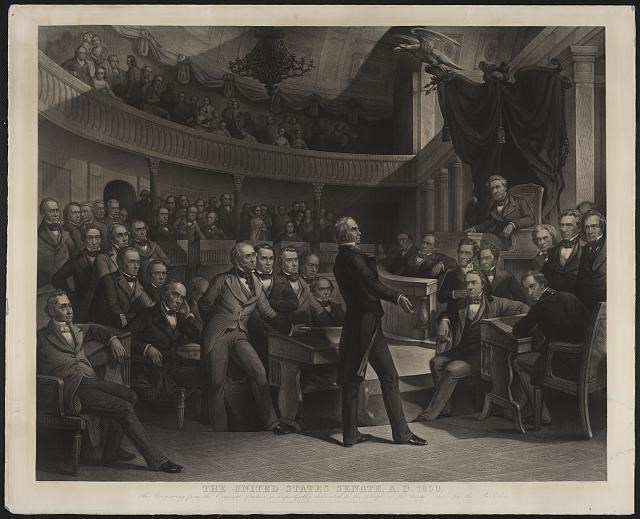
Library of Congress
With the Compromise of 1850, Webster could not leave slavery in the hands of southern governments. On March 7, 1850, Webster addressed the Senate and threw his support behind Clay's compromise. In what became known simply as the "Seventh of March" speech, Webster famously began by stating "I wish to speak to you today not as a Massachusetts man, nor as a Northern man, but as an American, and a member of the Senate of the United States."[13] He then endorsed the compromise and specifically called on Northerners to enforce the fugitive clause of the Constitution. Siding with the South, Webster stated that it is the role of Northern governments, "To do all that is necessary for the recapture of fugitive slaves and for their restoration to those who claim them…I say that the south has been injured in this respect and has a right to complain."[14]
While praised by Southerners, Webster's speech faced immediate backlash from his supporters in New England.[15] His constituents felt betrayed, and many believed he had sold his morals and turned his back on his region in favor of a presidential bid for the upcoming 1852 election. Reverend Theodore Parker called Webster a traitor, stating, "I know of no deed in American history, done by a son of New England, to which I can compare this but the act of Benedict Arnold."[16] Webster attempted to repair his reputation in New England, but the support of the compromise and the Fugitive Slave Law ended his chance at the presidency. Webster failed to receive the nomination in 1852 and died a few weeks later on October 24, from complications due to a carriage accident.
The Painting
A few months after Webster's death, in December of 1852, the Boston City Council voted to formally purchase a George Peter Alexander Healy painting that had been on display at Faneuil Hall since June of that same year.[17] The painting depicts Webster on the cusp of delivering his "Second Reply to Hayne" speech. A massive undertaking, the artist, George Healy spent four years working on the painting. Born in Boston, Healy's artistic talents brought him to Paris and eventually to King Louis Phillippe of France. The King commissioned Healy to do several portraits of prominent American politicians including Andrew Jackson, Daniel Webster, John C. Calhoun, Henry Clay, and John Quincy Adams.[18]
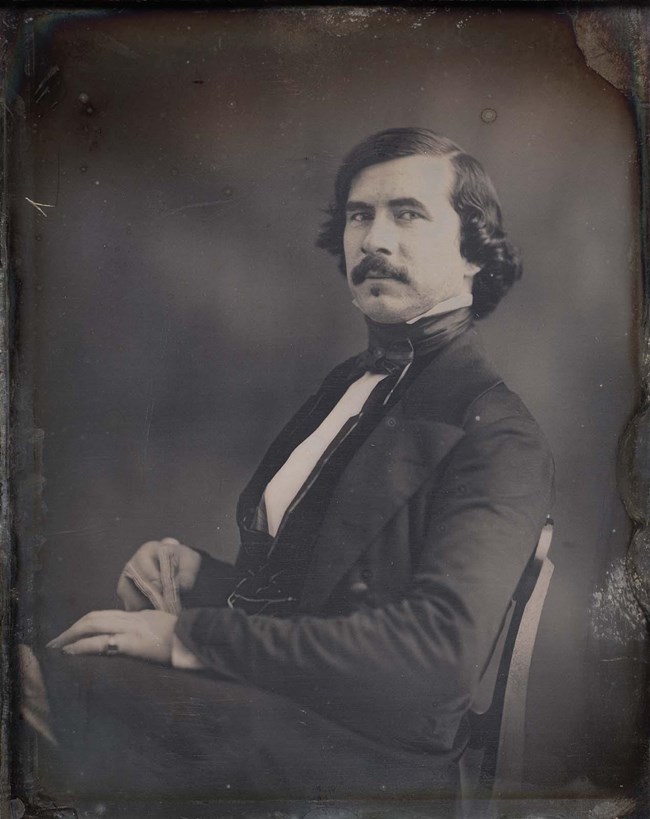
Museum of Fine Arts, Boston
With his growing success, Healy set his sights on creating a vast historic scene instead of a single portrait. He chose "Webster's Second Reply" as his subject, not only because of the speech's historical significance, but also due to Webster's financial support system. As author Frederick Voss wrote about Webster’s friends and allies, "Many in that circle had substantial personal wealth and an abiding devotion to Webster…Their magnanimity was enough to give Healy the impression that if he painted a large oil of Webster's final reply to Hayne, there would be a market for it in Boston."[19]
From 1846-1851 Healy worked sporadically on the painting in both America and Paris. During this time, however, a revolution in France forced King Louis Phillippe to abdicate the throne in 1848. With several incomplete commissioned pieces for the King, Healy worried about finances but pressed on with "Webster's Second Reply."[20] Completed in the summer of 1851, Healy brought it to Boston to be displayed at the Boston Athenaeum. He intended this stop to be the first leg of a national tour, where Healy hoped ticket sales for the painting's exhibition would offset expenses. The exhibition received mixed reviews, and the painting's massive size proved so large that moving it and finding galleries big enough became difficult and expensive.
With little interest for purchasing the piece, Healy became gravely concerned about his potential financial loss. However, as Webster's health began to decline, prominent citizens and local political leaders looked to have a fitting tribute for Webster. Boston's Common Council had recently voted to allow the painting to be display in the Great Hall at Faneuil Hall. They quickly passed a resolution for the purchase of the painting, stating,
Ordered: That an amount equal to the sum raised by individual subscription, but not exceeding twenty-five hundred dollars be and the same is here by appropriate for the purchase of Mr. Healy's picture of Webster Replying to Hayne, provide no conditions as to the time of its' remaining in Faneuil Hall be attached, but that the place of its deposit be discretionary with the Board of Mayor and Alderman.[21]
The painting, with exceptions for conservation, has remained on display at Faneuil Hall since 1852.
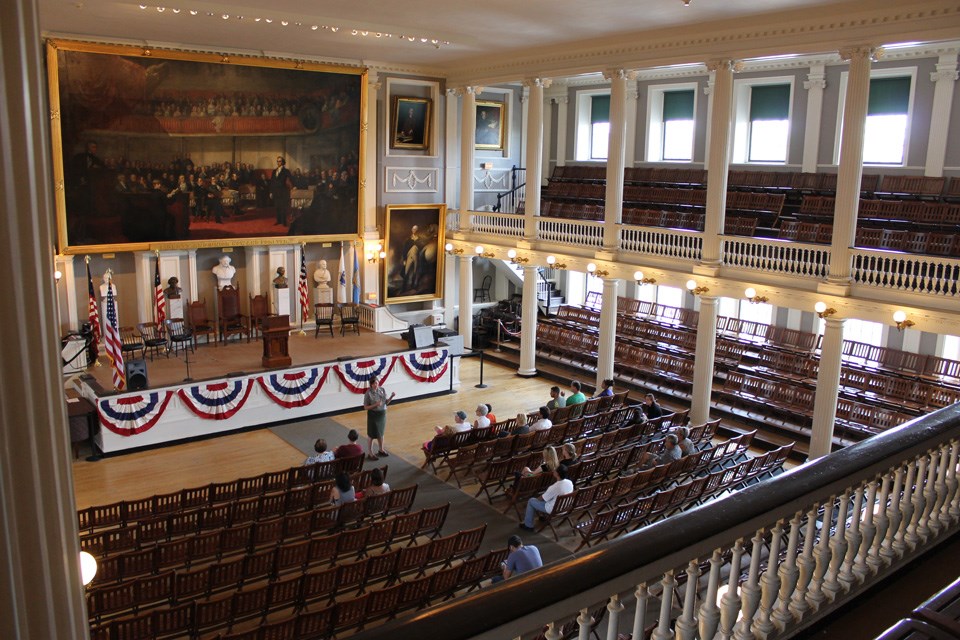
NPS Photo
The speech that Daniel Webster delivered on January 26, 1830, addressed the need to keep the United States together as one nation. Permanently hung in Faneuil Hall in 1852, the painting depicting Webster's speech served as the backdrop for debates over the 1850 compromise that Webster supported and ultimately led to the country tearing itself apart. To this day, debates within the Great Hall continue over the role of federal, state, and local governments on the stage in front of "Webster's Second Reply to Hayne." What is good government? What is our responsibility to ensure that this government, remains of, for, and by the people?
Footnotes
[1] Robert Remini, Daniel Webster: The Man and His Time (New York: W.W. Norton & Company, 1997), P. 328.
[2] Harlow Shiedley, "The Webster-Hayne Debate: Recasting New England's Sectionalism," The New England Quarterly, Vol. 67, No. 1 (March, 1994), P. 10.
[3] H.W. Brands, Heirs of the Founders: Henry Clay, John Calhoun, and Daniel Webster, The Second Generation of American Giants (New York: Anchor Books, 2018), P. 140.
[4] Ibid, p. 140.
[5] John C. Calhoun, Exposition and Protest, Reported by the Special Committee of the House of Representatives, on the Tariff (Columbia: D.W. Sims, State Printer, 1829), P.2. (Source Link)
[6] H.W. Brands, Heirs of the Founders: Henry Clay, John Calhoun, and Daniel Webster, The Second Generation of American Giants (New York: Anchor Books, 2018), P. 159.
[7]For more on the initial debates, see Rober Remini's Daniel Webster: The Man and His Time. P. 312-324.
[8] H.W. Brands, Heirs of the Founders: Henry Clay, John Calhoun, and Daniel Webster, The Second Generation of American Giants (New York: Anchor Books, 2018), P. 172.
[9] Robert Remini, Daniel Webster: The Man and His Time (New York: W.W. Norton & Company, 1997), P. 329.
[10] For more on the Compromise of 1850 and the series of resolutions proposed by Henry Clay see: H.W. Brands, Heirs of the Founders. P. 325-328.
[11] Webster's Speeches: Reply to Hayne (Delivered in the U.S. Senate, January 26th, 1830), The Constitution and the Union (Delivered in the U.S. Senate, March 7, 1850) With a Sketch of the Life of Daniel Webster, (Boston: Ginn and Company, 1897). P.13.
[12] Ibid. P. 16.
[13] Ibid. P. 103.
[14] Ibid. P. 142.
[15] To learn more about Webster's defense of the speech in Boston see Site of the Revere House Hotel
[16] Robert Remini, Daniel Webster: The Man and His Time (New York: W.W. Norton & Company, 1997), P. 677.
[17] Boston Common Council Records, December 30, 1852. Box 47, Volume 30. 1852.
[18] Frederick Voss, "Webster Replying to Hayne: George Healy and the Economics of History Painting," American Art, Vol. 15, No. 3 (Autumn, 2001), p.35 .
[19] Ibid. P. 38.
[20] Ibid. P. 39.
[21] Boston Common Council Records. December, 31, 1852. Box 47, Volume 30, 1852.
